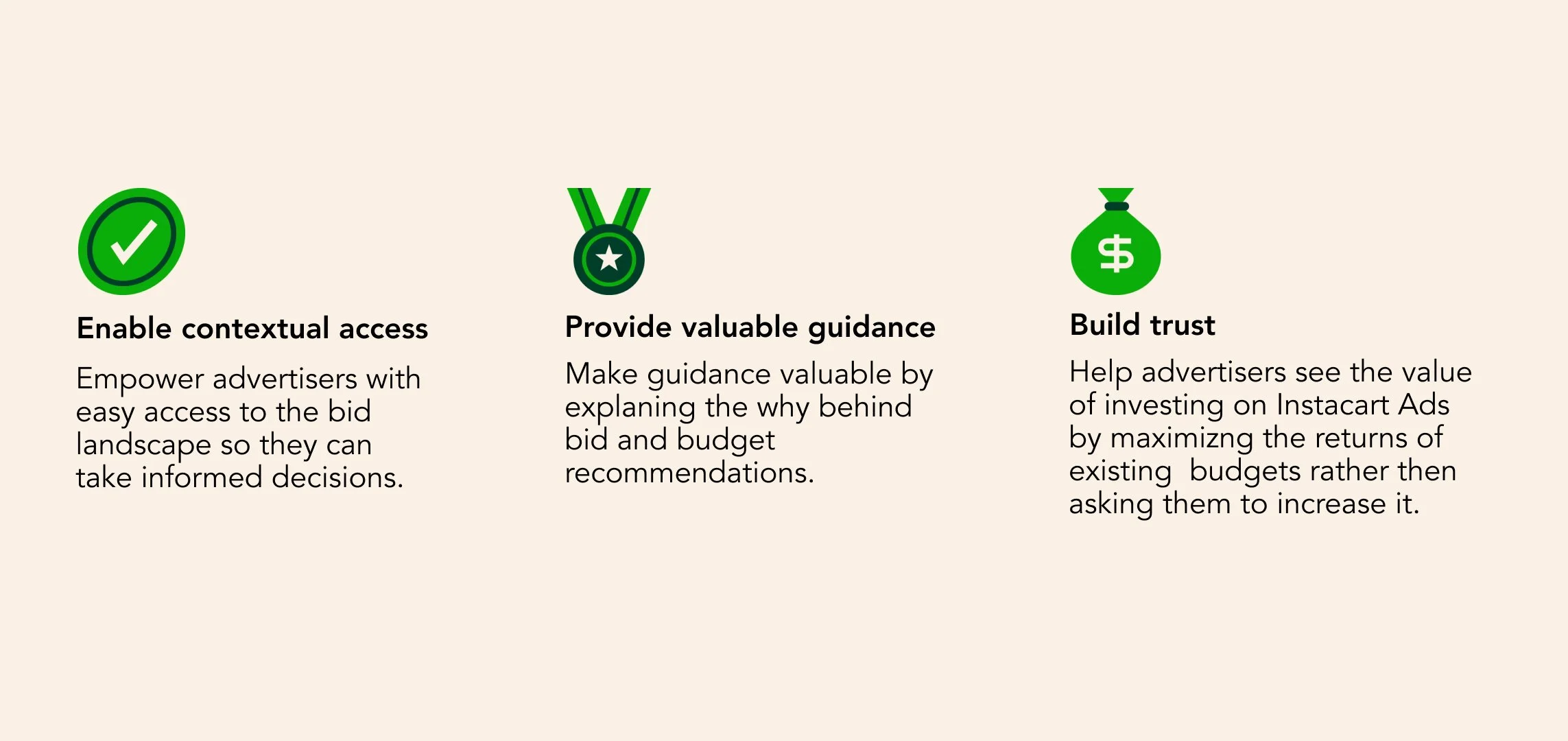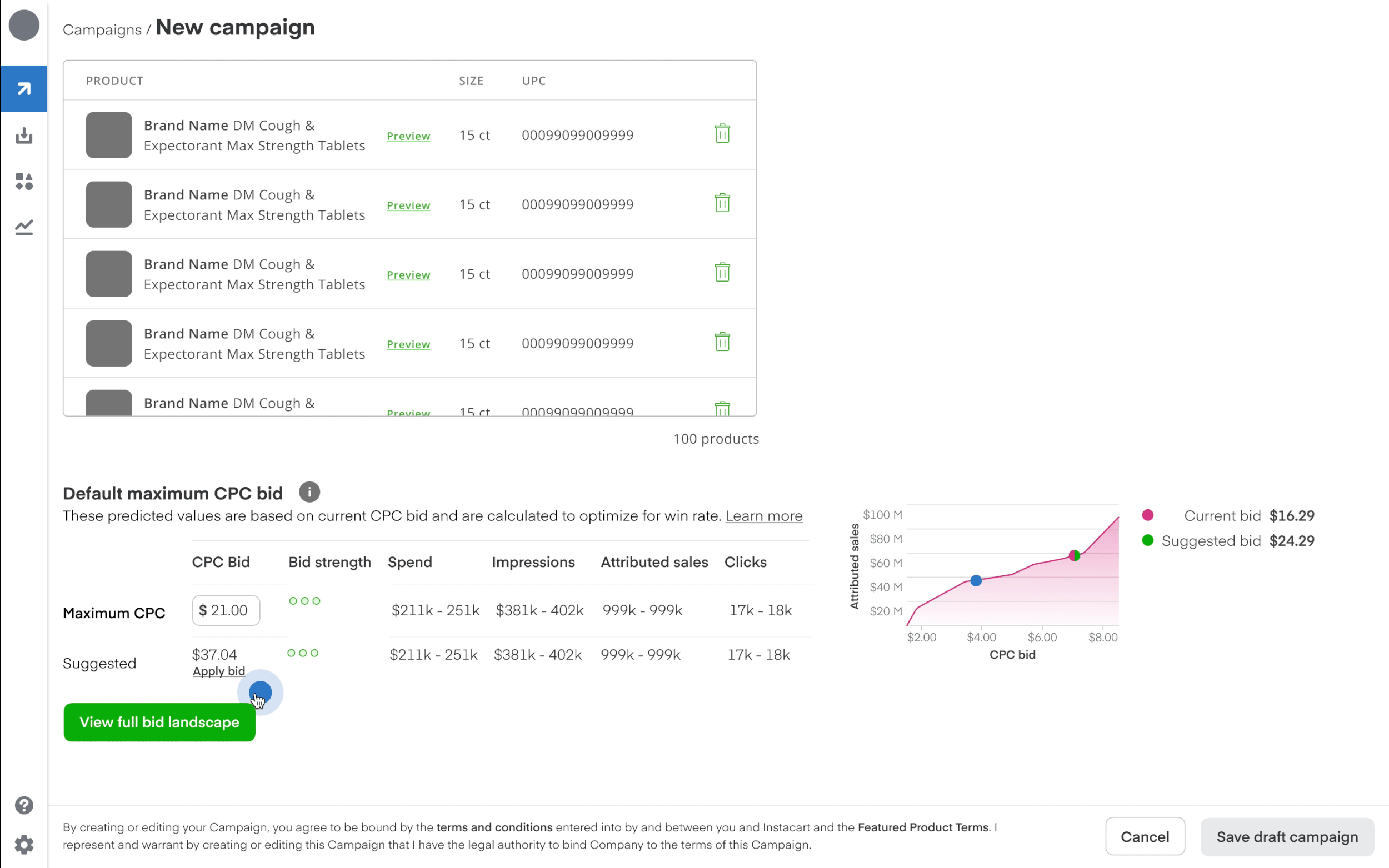PLATFORM
Web
TIMELINE
July 2021 - Sept 2021
WHAT IS INSTACART’S BID OPTIMIZER?
Instacart delivers groceries to it’s customers at their doorstep. Its a multi-marketplace platform where apart from grocery shopping, consumer brands can also advertise their products. A bid optimizer is a feature that aims to help advertisers set bids to rank their products higher and potentially lead to sales conversion.
ROLE
I was the Lead Product Designer focussing on designing features for the Optimization pillar in the Instacart Ads Manager platform. I reported to my manager for design feedback. Additionally, I worked closely with a PM and an engineering team to understand the bidding algorithm and define what metrics should be shown in the table.
BUSINESS OPPORTUNITY
How might we unlock incremental ad budgets on Instacart Ads Manager platform ?
For any ads business the most important aspect is to win advertiser trust, as it is hard to earn and easily lost. This trust is fundamental to execute the strategy of introducing less knobs and offering more automation to advertisers. But to get there, exposing more information on the bid’s returned value will is necessary. The biggest challenge is to help advertisers figure out what’s is the right cost-per-click that they want to bid for advertising “sponsored products” on Instacart’s marketplace.
MEMBER PROBLEM
Low transparency on the expected outcome
When advertisers come to the Ads Manager platform, they have fixed budgets and are looking to get maximum returns on their investment on Instacart Ads. Choosing the right bid to bet with is crucial for them as that value determines if their ads will be served or not. If they choose a bid that’s too high, they may end up exhausting all their budget too quickly and with nominal returns. Hence, helping them choose the most optimal bid that also works with their existing budget is important to make a campaign successful.
The existing solution, only showcases a list of bid options, their respective performance metrics and a suggestion. We heard feedback from advertisers that this experience is deficit in terms of conveying the “why” a certain value is suggested and how does it optimize their current budget.
Old experience
UNDERSTANDING THE USER FLOW
Gathering advertiser intent
My first step was to understand the campaign structure and the flow of information from campaign to ad group level and vice-versa. I created flow charts of the campaign creation and post launch flow to uncover use cases where for advertisers would need to edit their bids. This helped me understand different levers related to budget, bid settings and how advertisers could pull them to get a desired outcome.
I also realized that the current experience was lacking the application of advertiser’s intent (which was only captured in the setup flow) and using it to design a more objective-based experience. Advertisers objective was an opportunity that needed to be leveraged to determine which knobs Instacart’s Ads platform should provide so advertisers could get results that aligned with their goals.
Campaign creation flow and highlighted areas for showing bid landscape
design tenets
Design principles for guidance
After going through the qualitative feedback, distilling the user needs and auditing the pain points of the existing experience, next step was a FigJam session with my Product Manager to come up with design principles that were going to guide us in the decision making process. I also shared these with Search’s Product leadership during a design critique session to gather any feedback and ensure we were aligned on the common goal.
DESIGN DETAILS
Improved bid landscape experience
A modular, side-drawer interface to showcase the bid landscape data
I replaced the centered modal with a side drawer to leverage vertical screen height, so that it could fit more information and scale for other similar sub-task based use cases.
This was a new pattern that I contributed towards the Tooling design library which is adopted by other use cases across Ads Manager for performing sub tasks.
My design explorations and iterations for the bottom sheet design
Onboarding screen to drive awareness of the improved feature
In order to increase the adoption of this feature, it was important to not only make advertisers aware of the improved feature, but also communicate all the surfaces across the use cases where this tool would be available to advertisers. I leveraged the onboarding component from Instacart’s design system to surface these cards on Campaign overview, Ad group edit and recommendations page, with a cool off logic that it will only appear once on each of these surfaces until advertiser dismisses them once.
Onboarding card on Ad group creation page
Bid landscape’s drawer design
While designing the details that go inside the drawer, I used the pilot designs as a baseline and kept the information hierarchy as is i.e. a title with description, table to show all the bid options and a graph to show quick comparison between the suggested, current and selected bids.
In the design explorations, I added additional an additional data point of the estimated spend at the ad group level, as it would give advertisers an idea of how much they would end up spending if they went with a specific bid option. I also added a line of data exposing their current budget so that advertisers could compare their spend with remaining budget. This way they could make a more informed decision.
Customize data columns
Based on their campaign objective, advertisers looked to optimize their bids based on specific performance metrics. Initially, I considered exposing all the performance metrics, with a horizontal scroll UI so advertisers had the option to visualize the outcome. However, after doing an in-depth competitive analysis, I noticed that there was also an industry pattern of giving advertisers a “customize columns” option that would allow them to choose a fixed no. of data columns. So I decided to change my initial approach and used a dropdown component to customize the data columns. I also decided that based on the campaign objective, there would be a default set of columns that would be exposed. This way we were customizing the overall experience as per advertiser intent and speeding up their optimization process.
Contributing to Tooling design system
While applying the side drawer as a design solution for this project, I realized that there were a lot of other use cases across the Instacart Ads Manager product that could leverage this pattern for doing sub tasks, while maintaining the context. During the team design critique sessions, I advocated for the scalability of this pattern and proposed adding it as a component to the tooling design system. My suggestion was adopted and the drawer was added as a component to the tooling design system.
IMPACT
Higher adoption and budget burn rate
9.3% improvement in bid recommendation adoption (significant)
As per quantitative feedback, we recorded a significantly higher adoption of suggested bid recommendations. We also received qualitative feedback from advertisers that they found the customize columns feature very useful to make informed decisions.
Budget burn rate improved by 8.2% (stat significant) from 56.2% to 64.4% for adopting advertisers
Approximately, 40% of sponsored product campaigns had unspent budget due to which they were not using the platform to it’s fullest potential. From a business perspective, for Instacart there was revenue left on the table. Due this feature, the budget burn rate significantly improved for advertisers who adopted and referenced the bid landscape.
To learn how about how I also designed the recommendation system for bid optimization, please email me at rusheka91@gmail.com










